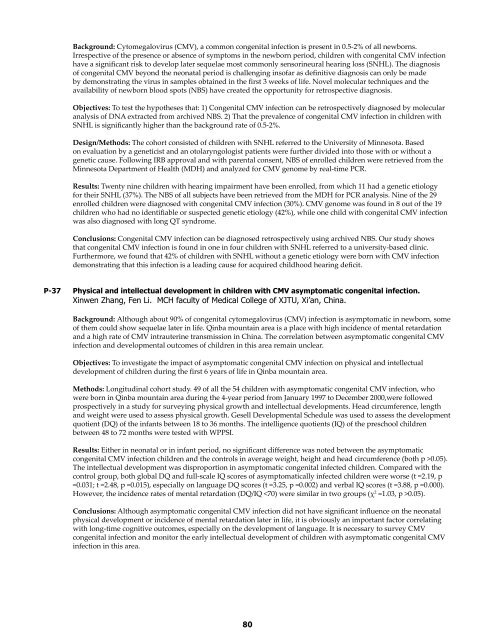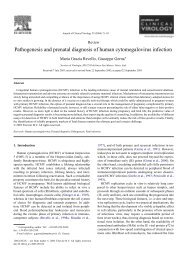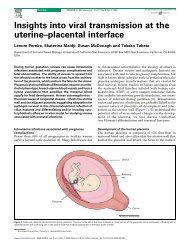Congenital Cytomegalovirus Conference - Congenital CMV ...
Congenital Cytomegalovirus Conference - Congenital CMV ...
Congenital Cytomegalovirus Conference - Congenital CMV ...
You also want an ePaper? Increase the reach of your titles
YUMPU automatically turns print PDFs into web optimized ePapers that Google loves.
Background: <strong>Cytomegalovirus</strong> (<strong>CMV</strong>), a common congenital infection is present in 0.5-2% of all newborns.<br />
Irrespective of the presence or absence of symptoms in the newborn period, children with congenital <strong>CMV</strong> infection<br />
have a significant risk to develop later sequelae most commonly sensorineural hearing loss (SNHL). The diagnosis<br />
of congenital <strong>CMV</strong> beyond the neonatal period is challenging insofar as definitive diagnosis can only be made<br />
by demonstrating the virus in samples obtained in the first 3 weeks of life. Novel molecular techniques and the<br />
availability of newborn blood spots (NBS) have created the opportunity for retrospective diagnosis.<br />
Objectives: To test the hypotheses that: 1) <strong>Congenital</strong> <strong>CMV</strong> infection can be retrospectively diagnosed by molecular<br />
analysis of DNA extracted from archived NBS. 2) That the prevalence of congenital <strong>CMV</strong> infection in children with<br />
SNHL is significantly higher than the background rate of 0.5-2%.<br />
Design/Methods: The cohort consisted of children with SNHL referred to the University of Minnesota. Based<br />
on evaluation by a geneticist and an otolaryngologist patients were further divided into those with or without a<br />
genetic cause. Following IRB approval and with parental consent, NBS of enrolled children were retrieved from the<br />
Minnesota Department of Health (MDH) and analyzed for <strong>CMV</strong> genome by real-time PCR.<br />
Results: Twenty nine children with hearing impairment have been enrolled, from which 11 had a genetic etiology<br />
for their SNHL (37%). The NBS of all subjects have been retrieved from the MDH for PCR analysis. Nine of the 29<br />
enrolled children were diagnosed with congenital <strong>CMV</strong> infection (30%). <strong>CMV</strong> genome was found in 8 out of the 19<br />
children who had no identifiable or suspected genetic etiology (42%), while one child with congenital <strong>CMV</strong> infection<br />
was also diagnosed with long QT syndrome.<br />
Conclusions: <strong>Congenital</strong> <strong>CMV</strong> infection can be diagnosed retrospectively using archived NBS. Our study shows<br />
that congenital <strong>CMV</strong> infection is found in one in four children with SNHL referred to a university-based clinic.<br />
Furthermore, we found that 42% of children with SNHL without a genetic etiology were born with <strong>CMV</strong> infection<br />
demonstrating that this infection is a leading cause for acquired childhood hearing deficit.<br />
P-37 Physical and intellectual development in children with <strong>CMV</strong> asymptomatic congenital infection.<br />
Xinwen Zhang, Fen Li. MCH faculty of Medical College of XJTU, Xi’an, China.<br />
Background: Although about 90% of congenital cytomegalovirus (<strong>CMV</strong>) infection is asymptomatic in newborn, some<br />
of them could show sequelae later in life. Qinba mountain area is a place with high incidence of mental retardation<br />
and a high rate of <strong>CMV</strong> intrauterine transmission in China. The correlation between asymptomatic congenital <strong>CMV</strong><br />
infection and developmental outcomes of children in this area remain unclear.<br />
Objectives: To investigate the impact of asymptomatic congenital <strong>CMV</strong> infection on physical and intellectual<br />
development of children during the first 6 years of life in Qinba mountain area.<br />
Methods: Longitudinal cohort study. 49 of all the 54 children with asymptomatic congenital <strong>CMV</strong> infection, who<br />
were born in Qinba mountain area during the 4-year period from January 1997 to December 2000,were followed<br />
prospectively in a study for surveying physical growth and intellectual developments. Head circumference, length<br />
and weight were used to assess physical growth. Gesell Developmental Schedule was used to assess the development<br />
quotient (DQ) of the infants between 18 to 36 months. The intelligence quotients (IQ) of the preschool children<br />
between 48 to 72 months were tested with WPPSI.<br />
Results: Either in neonatal or in infant period, no significant difference was noted between the asymptomatic<br />
congenital <strong>CMV</strong> infection children and the controls in average weight, height and head circumference (both p >0.05).<br />
The intellectual development was disproportion in asymptomatic congenital infected children. Compared with the<br />
control group, both global DQ and full-scale IQ scores of asymptomatically infected children were worse (t =2.19, p<br />
=0.031; t =2.48, p =0.015), especially on language DQ scores (t =3.25, p =0.002) and verbal IQ scores (t =3.88, p =0.000).<br />
However, the incidence rates of mental retardation (DQ/IQ 0.05).<br />
Conclusions: Although asymptomatic congenital <strong>CMV</strong> infection did not have significant influence on the neonatal<br />
physical development or incidence of mental retardation later in life, it is obviously an important factor correlating<br />
with long-time cognitive outcomes, especially on the development of language. It is necessary to survey <strong>CMV</strong><br />
congenital infection and monitor the early intellectual development of children with asymptomatic congenital <strong>CMV</strong><br />
infection in this area.<br />
80





